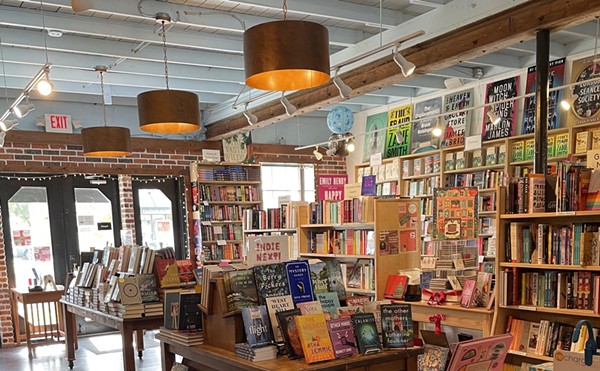Few artists pioneer an entire movement. Miriam Schapiro was in the vanguard of two: Pattern & Decoration painting and the first wave of feminist art, breaking ground for generations of women.Maybe that's why there's a hum in the air this October evening at the University of Tampa's sparkling new R.K. Bailey Art Studios. Guests have gathered for a preview of the inaugural exhibition, the stunning Miriam Schapiro in Tampa, beautifully mounted and lit in the building's Scarfone/Hartley Gallery. Schapiro is here for the opening, and there's a collective anticipation that's almost palpable.
Or maybe the buzz is attributable to the work itself. Consider the dazzling fan-shaped "Pleasure Dome," for instance, on the far back wall of the gallery. The title is more than apt: meticulously applied fabric infused with vivacious color and pattern translates surface into all-over pageantry. It's deliciously, decadently decorative, a 21st-century echo of the '70s P&D movement, that shows the artist, now 80, at the top of her form. At the same time it suggests the dualities that have always flowed through Schapiro's life and art, its organic floral patterns pulsing against the order and precision of the fan's colorful struts.
As Schapiro mingles with the crowd, you catch glimpses of her complex persona. Dressed simply in black, gray hair stylishly coiffed, her warm smile accented by bright red lipstick, she's a diminutive woman who seems comfortable in her own skin. A public artist, she thrives on collaboration. Yet she also retains a zone of privacy, the aura of someone fiercely protective of her own boundaries.
A fighter and a nurturer; a champion of independent women artists whose work pays tribute to homemakers' crafts; a crusader against the male power structure whose own career benefited from a supportive father and husband — Miriam Schapiro is as complex and fascinating as the art she creates.
This season, Tampa Bay has a rare opportunity to learn more about her. In addition to her exhibition, on Oct. 12 she'll lecture about her career, and, culminating her two-week residency at UT's STUDIO-f print facility, during a reception on Friday evening, Oct. 15, the public is invited to view her mono-prints.
But the best place to begin talking about her remarkable journey is in her own home.
JUNE IN THE HAMPTONS
It's my first foray to this Long Island mecca for artists, wannabes and summering celebs. Schapiro lives here, in Wainscott, N.Y., one of the small picturesque towns within greater East Hampton, and, in anticipation of the Tampa exhibition, I'm meeting her for an interview and lunch.
The artist greets me at the door of her weathered clapboard house. Inside there's the ambiance and illogic of an older home; in the back, overlooking a small pristine wooded yard, is an informal living room with paintings by Schapiro and her husband, Paul Brach.
She insists that my husband join us for lunch, together with her assistant and Brach, a formidable figure in his own right: painter, influential administrator and educator, and occasional critic. A table set by the kitchen window is a charming backdrop to lively conversation ranging from the casually erudite to art world gossip. Married since 1946, the couple's friends drew from a legendary art crowd with names like Jackson Pollock, Lee Krasner and Willem DeKooning, most of whom populated the area in the early '50s. Memories remain fresh: Brach remembers sitting up nights with Krasner, Pollock's wife, while the notoriously self-destructive artist was out "drinking and driving around." (Pollock died in a 1956 auto accident.)
The Schapiro-Brach pair are legends themselves now, each a key player — one out front and one behind the scenes — during one of the most dynamic art epochs of the 20th century. But at lunch, it's not Schapiro's status as art-world powerhouse that you're aware of; it's the "nurturing, maternal" persona described by her major collector and friend, Winter Haven's Norma Canelas Roth. Roth defines the artist as "especially protective" of Paul, but also "tough as nails — the female warrior side."
After lunch the artist leads me from the kitchen through her office, pointing to family photos on the wall, and then into her studio. Skylights and clerestory windows light the room, where a large table holds unfinished works on paper. Stacked against walls are exuberant canvases, mostly from the last two decades, some with seductive, mesmerizing and methodical elements of P&D. I had only seen these works in catalogs, paintings she innovated with fabric cutouts glued onto spray-painted backgrounds; she calls them "femmages" (female + collage), a word she coined, now synonymous with her name and the process. Both reflect her advocacy of anonymous women and crafts considered women's work.
Schapiro asks if I'd like to see the cabinet where she stores her fabrics. She leads me to a darkened storage closet in the back of the studio, turns on the light and opens a wooden chest, its shelves stacked with folded fabrics. It's a touching moment as the artist shares the patterned material she's collected, some from flea markets she frequents while lecturing or opening exhibitions around the country. Here is the symbolic heart of her art-making.
I ask how she chooses particular fabrics. "I'm looking for the third picture," she says. "Certain fabrics have stories in them. It's one of these enigmatic experiences when you're making art, like having an angel on your shoulder. I'm very close to my instinct and I always trust my instinct."
She lifts a cardboard carton off the paint-stained cement floor. It holds an assortment of old rag dolls, like the fabrics, collected on travels and used as subject matter for the last three or four years, though dolls have appeared in her work as far back as the late '50s. Her connection to dolls goes deep; her grandfather Aaron Cohen, a Russian immigrant, invented moveable dolls' eyes in America. She shares the story of how his chance meeting with a man on a Brooklyn park bench led to their co-founding the business that became the Ideal Toy Company (eventually sold to Mattel).
During her UT residence, Schapiro is creating monoprints using doll images she's photographed, digitally scanned and printed in her own studio. She'll convert the reality of her prized dolls into two-dimensional replicas connecting her family heritage, the paper dolls she loved as a child, and the art that is her passion.
Invited by Dorothy Cowden, Scarfone-Hartley Gallery and STUDIO-f director, she'll work with Master Printer Carl Cowden. During the '80s, she printed at Berghoff-Cowden Gallery and at Graphicstudio, where she produced lithographs like "Children of Paradise," included in the exhibition.
Using digitalization is not the technological leap you'd expect for a woman born in 1923. Though she's had little recognition for it, in the late '60s she was one of the first artists to have drawings transferred into computerized art through collaboration with California physicist David Nalibof.
BEGINNINGS
Schapiro was not always a trailblazer.
Her personal evolution from artist to influential arts activist has roots in childhood and in the 1940s, when Schapiro and Brach met and married during art school at the University of Iowa. After graduate school Brach taught at the University of Missouri while his wife — with equally valid art credentials — worked in a bookstore.
Back in New York City (she had grown up in Brooklyn, he in Manhattan), they met rising artists like Jasper Johns, Helen Frankenthaler and Robert Rauschenberg. They hung with the crowd at the Cedar Bar in Greenwich Village, where intellect and angst metamorphosed into the romantic lore that came to define the New York art scene. Brach, who taught at many city art institutions, was a respected contributor to the mostly male group. "Mimi" (as her friends know her) was shy and "nearly invisible," he said.
Schapiro — who would spend decades crisscrossing the country, lecturing, leading consciousness-raising sessions with several generations of female artists — is candid about her less confident younger self, describing herself as "tongue-tied."
Miriam adopted every new style, while admitting, "My rebelliousness was always in my art." Abstract expressionist canvases exuded a creamy lyrical sensibility hinting of the feminine but reflecting her affinity for architectural elements. Then came "shrines," compartmentalized towers with egg-shaped ovals, forerunners to the autobiographical woman-centered art that would define her work. Switching from oil to acrylic, she painted elongated cubes, choreographed as if frozen in space.
After debuting in a Museum of Modern Art exhibition, she signed with the prestigious Andre Emmerich Gallery.
Yet all was not well.
Despite increasing fame, she remained torn between the powerful internal energy of an artist and societal expectations of domesticity and child-rearing (the couple's only child, Peter, was born in 1955). Few women artists had succeeded; most were considered hobbyists. "I was raising our son, juggling two worlds. It was a man's world. ... I didn't have the language for it then, but I realized something was wrong."
Childhood observations of her mother — housebound and isolated, an expert in domestic "arts" — had left her with unresolved conflicts. Her father, Theodore Schapiro, had been an artist and industrial designer. During the Depression he worked on the WPA and transmitted his love of art to his only child. When she was 14, he fudged her age to get her into a life drawing class with nude models.
She remembers him as "very imposing-looking, good-looking, tall and dark," standing behind her when the teacher asked her age. He asked how old she had to be. When the teacher said 19, he pushed his daughter forward. "She's 19," he responded. Miriam first memorialized their relationship in an animated figurative painting called "Father and Daughter" (1997), the dancing pair echoing her monumental, 35-foot cast aluminum and paint public art project, "Anna and David" (1987), in Rosslyn, Va.
CALIFORNIA BOUND
In 1967 Brach was offered the University of California/San Diego art department chair, a move with less promise for Miriam. Her memories are bittersweet. "I left New York, my family, all my friends, my network, my gallery ... everything that I had going for me."
Brach refused the position until a teaching job and studio was arranged for his wife, and they moved across the country and transferred their son to a new school. On Paul's first day, the provost made a bombshell announcement: "Miriam's job has just been rescinded and there's not much I can do about it."
Schapiro relates her husband's classic fakeout — his hand poised on the doorknob, starting to turn it — "play[ing] the biggest poker bluff of his life." Stakes were high.
"'I'm sorry. If she can't be here, I can't be here,'" he told his new boss.
The bluff worked. Schapiro was hired and given a studio.
Two years later Brach became dean of the California Institute of the Arts (Cal-Arts), and under his leadership the school became one of the most progressive and influential art institutions in the country.
LEADING THE CHARGE
Perhaps it was the feminist movement smoldering in the East. Perhaps it was the California zeitgeist. But in 1968, Schapiro created her first overtly feminist work, apparently without realizing it: the computer-generated painting "Ox," in which the juxtaposed letters O and X form a "central-cavity void," an iconic female symbol.
Then, in 1970, Schapiro met the pioneering feminist artist Judy Chicago. They discussed common gender and societal interests, and proposed the innovative Feminist Art Program, which they team-taught at Cal Arts. Brach helped convince male faculty that the program was necessary; and Schapiro, not afraid to turn the traditional woman's role to her own advantage, invited each to dinner.
Paul Brach deserves more than a passing tribute for his strategic role in this historical scenario.
I asked him whether his mother's Master's degree — a rarity for a woman in 1920 — influenced his unflagging support for his wife and for the incipient feminist art movement. It wasn't a conscious connection, he said. His mother "put her professional and intellectual life aside." His wife "had conflicts, but she wouldn't put either [one] aside."
Schapiro and Chicago picked 21 women for their groundbreaking collaborative project, "Womanhouse," described by art historian Gail Levin as "an ambitious and notorious project that would mark a turning point in art history." Intense consciousness-raising sessions led to the purchase of a condemned 17-room Los Angeles mansion as a venue for performances and art from a woman's perspective.
"'Womanhouse' was a revelation. You knew immediately you were in the face of something you'd never seen before in the art world," Schapiro reminisces. This was an understatement: Chicago's "Menstruation Bathroom" and "fried-egg breasts" clinging to kitchen walls were two of the assorted female confessional projects. This was 1972.
The artist and her student/assistant, Sherry Brody, contributed "The Dollhouse," one of the installations. If ever one could claim that a turning point in a career was based on a 5" x 10" whiskey box, this was it. Boxes glued to each other formed a six-room house in which subliminal fears were juxtaposed against supposedly benign interiors — hardly a salute to Barbie and Ken.
Schapiro created the tiny room called "Seraglio" (a harem) covered with richly patterned Middle Eastern textiles. Calling it the "greatest epiphany" of her life, this breakthrough process led to her collaborative series honoring historic female artists. Gluing fabric swatches around reproductions of their works was the genesis of the "femmage" process.
National and international media flocked to "Womanhouse" (now in the collection of the National Museum of American Art). The impact of the Schapiro/Chicago Storm the Bastille assault on a male-dominated art world was staggering. "Womanhouse" was a rallying cry to liberate women's emotional lives, to reject weary art styles, and to utilize female autobiography as subject matter. Because of "Womanhouse," barriers to gender equality in American arts education were leveled and entrenched styles disrupted, opening the way for Postmodernist democratization.
"My life would never have been what it is today if I hadn't had that eight years in California."
Nevertheless, in 1975, anxious to recharge their careers, the couple returned to N.Y.
Miriam showed her 10-paneled, 50-foot "Anatomy of a Kimono" femmage at the Andre Emmerich Gallery (its monumentality and "walk-in" sensibility distantly reminiscent of Jim Rosenquist's signature painting installation, "F-111"). Rejecting her use of fabric as medium and feminist concerns as content, the gallery broke its long alliance with her.
In the mid-1970s, along with famed artists Robert Zakanitch, Valerie Jaudon, Joyce Kozloff and others, she helped found the P&D movement, also known as Pattern Painting. P&D artists, often employing an underlying grid, reinterpreted designs hinting of ancient and exotic origins, or of quilt-making legacies, a Schapiro favorite.
Pattern painting enjoyed popularity during the late '70s and early '80s, and was enormously successful in Europe. "It was the first time in my life I'd ever seen real money," Schapiro says.
P&D was eventually subjected to derision, ironically because of its strong aesthetic appeal. Yet those condemning the style may have missed something — a craving for beauty that is innately human.
PICTURES AT AN EXHIBITION
Miriam Schapiro in Tampa offers strong proof that beauty can be enough.
Twenty works from the late '70s to the present offer a partial overview of the artist's oeuvre.
Dolls figure into several images. The subject matter may seem naive for a contemporary artist (though James Rosenquist has a painted series), but Schapiro's use of them is anything but naive. "Curtain Call" places its cast of doll characters against a theatrical background — another familiar Schapiro device — and "Big Boy #1," one of her favorites, bridges dolls and pop culture. In the richly hued "Life of Dolls" (2003), randomly placed dolls are visually stabilized by the rigid geometry of a circle and rectangle.
Schapiro's familiar visual motifs — her "lexicon of forms" — are everywhere: fans, hearts, houses, robes called "vestitures," kimonos endowed with cross-cultural and cross-gender meanings. Simple, but not simplistic.
In "The Poet" (1983), a huge, ironic but noble tribute to women, a gentle maelstrom of whirling hearts, houses and teapots is scattered randomly against a field glowing with pinks, reds and oranges.
During the late '80s, the artist began a commemorative series on revered feminist cult figure Frida Kahlo. "Frida and Me" is a 1990 lithograph based on the monumental (72" x 152") "Conservatory" (1988), a glorious, hard-to-tear-yourself-away-from melange of paint and fabric (shown in a 1999/2000 retrospective at Lakeland's Polk Museum of Art). Schapiro biographer Thalia Gouma-Peterson suggests the Frida/Miriam composite portrait infers common Jewish heritage (Kahlo was half Jewish), of growing interest to an artist who has only recently begun to express her own ethnicity and religion in her art.
But not all the art in the exhibition reveals her sensuous side.
During the mid-1990s, prompted by her Russian/Jewish heritage, the artist devoted a series to Russian women artists. "Women Artists of the (Russia's) New Age," xerox on cut paper, combines patterns, costumes, hearts and doilies, and a realism we're unused to seeing in her work. "Sorrow and Joy" (2003) is unique for other reasons. A poignant interpretation of the 9/11 event, its grayed tones are subtly touched by color. The mythological Persephone figure signals the promise of regeneration and rebirth.
BORN AGAIN
"We see so many people working today who don't know to whom they owe their debt," says Norma Roth. She and her husband, William Roth, prominent benefactors of the Polk and Orlando Museums of Art, are listed by Art & Antiques Magazine as among the top 100 collectors in the country.
They are perhaps Schapiro's biggest fans; they donated a huge Schapiro triptych to the Orlando Airport, and are major collectors of P&D. The Roths understand Schapiro's contributions as well as anyone.
And indeed, her contributions to subsequent generations of women artists are nearly incalculable. She helped found the feminist journal Heresies, and lectured, earning the nickname "Mimi Appleseed" after collecting slides from unknown female artists and sharing them with other women — the "largest private archive of woman artists," she says.
And the accolades that signify success for an artist are legion: work in major museum collections around the world; six honorary doctorates; numerous awards, including the 2000 College Art Association's Lifetime Achievement Award.
But what continues — what's most important — is the work. And Schapiro, at 80, is working at a level as high as she ever has.
"Asian Rendezvous" (2003), a femmage absent from this exhibition, illustrates the artist's ability to surge at this stage of her life and career. Brazenly decorative, with exquisite yellow-gold coloration, it is by all measures a consummate synthesis of fabric and paint. When I viewed it in the artist's N.Y. gallery, I was struck by its triumph of delicacy and dynamism, oriental motifs and floral patterns coalescing into a cosmic universe. Works like these — in any media — satisfy a deep-rooted, unapologetic, turn-back-the-clock celebration of beauty.
Artist Robert Zakanitch writes: "Beauty is. It is as natural as breathing. Its allure is transforming and I never thought art was about anything else."
Amen.
Adrienne M. Golub is a frequent Weekly Planet contributor. Comment on her story by writing to [email protected].















